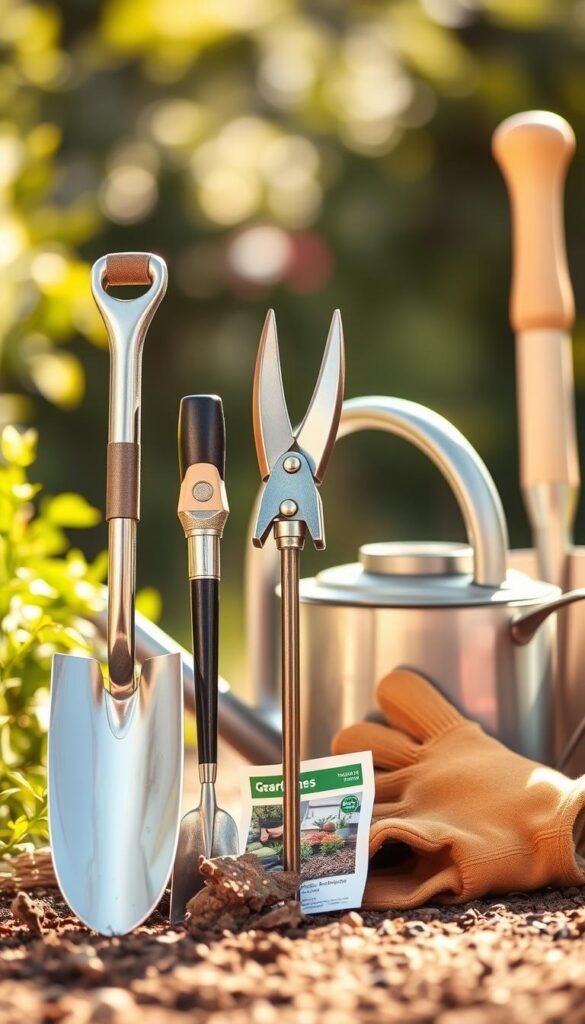Starting your journey in cultivating plants can feel overwhelming. With countless options available, it’s easy to overspend or clutter your space with unnecessary items. Focusing on quality essentials saves money and ensures long-term success.
Experts like Linda Hagen and Ellen Hoverkamp recommend a minimalist approach. Instead of buying every gadget, prioritize durable, versatile pieces. This guide simplifies the process by distinguishing must-haves from optional extras.
We’ll explore budget-friendly alternatives and organic options, all while keeping a friendly, judgment-free tone. Whether you’re planting herbs or flowers, smart choices make the experience enjoyable and rewarding.
Essential Gardening Tools Every Beginner Should Own
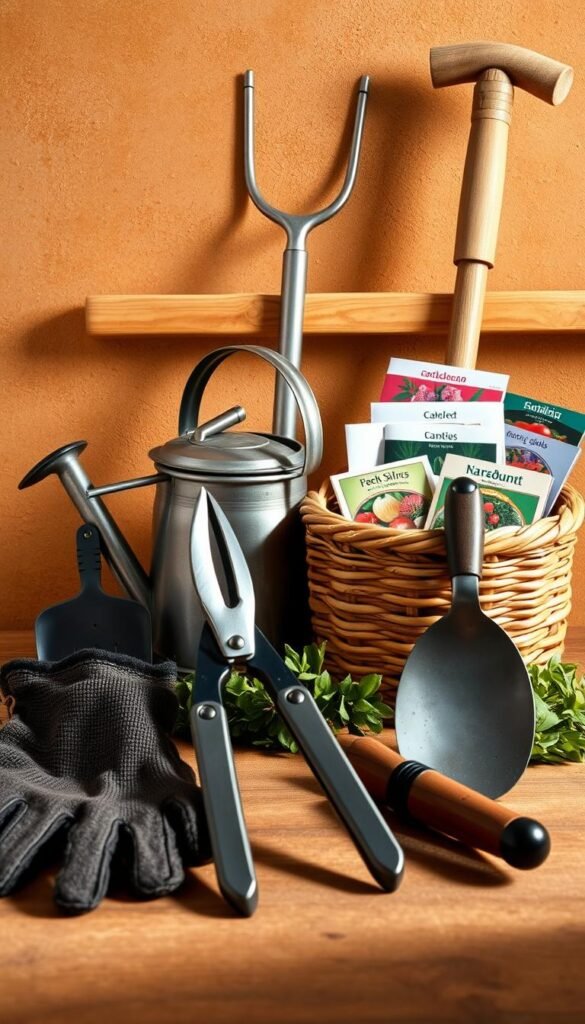
Building a solid foundation starts with a few key items. These basics help you plant, maintain, and enjoy your green space without frustration. Quality matters—durable materials save time and money in the long run.
Gloves: Your First Line of Defense
Protect your hands from thorns, blisters, and dirt. Look for breathable fabrics like cotton or leather. A snug fit ensures precision while gripping small plants or tools.
Hand Pruners: The Gardener’s Scissors
A sharp blade makes clean cuts, promoting plant health. Bypass pruners work well for live stems, while anvil types handle deadwood. Wipe the steel after each use to prevent rust.
Trowel: The MVP of Small Jobs
This compact tool tackles digging, transplanting, and weeding. The Garrett Wade Tulip Trowel stands out for its forged steel construction. Narrow blades suit tight spaces, while wider ones move soil faster.
- Curved edges slice through roots effortlessly
- Measurement markings ensure perfect depth for planting bulbs
- Rub beeswax on wooden handles to avoid splinters
Stainless steel resists corrosion, making it ideal for damp conditions. Forged options last longer than stamped metal versions. Keep it clean and dry to maintain its edge.
Must-Have Tools for Beginners
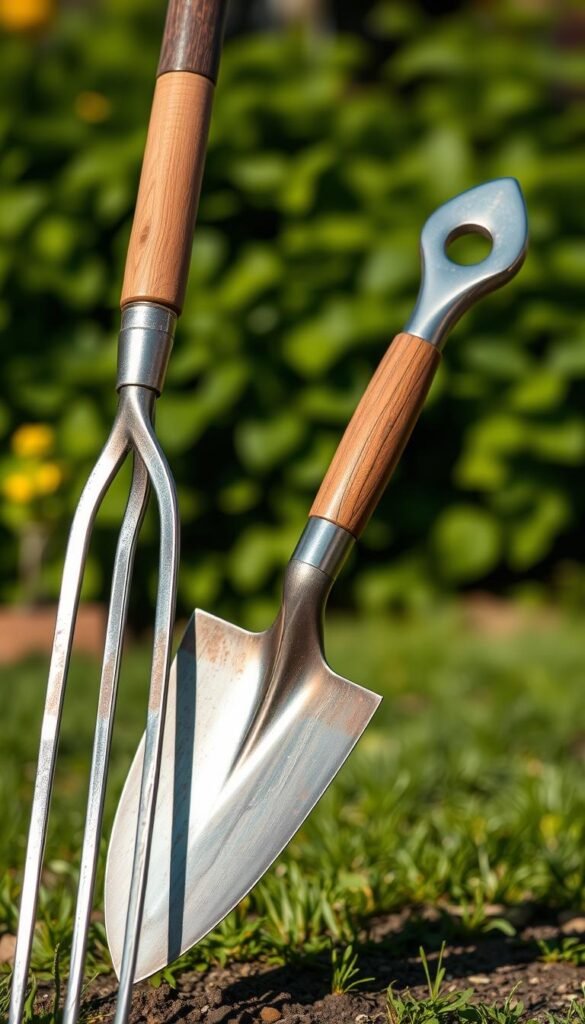
Tackling tough dirt and compost requires sturdy, reliable tools. Two standouts—the garden fork and spade—handle heavy-duty tasks while saving your back. Invest in these, and you’ll breeze through soil prep and planting.
Garden Fork: For Tough Soil and Compost
This tool’s sharp tines break up compacted earth effortlessly. Opt for a forged steel head—it won’t bend under pressure. The garden fork also aerates compost piles, speeding up decomposition.
Spade: Digging and Edging Made Easy
The spade’s flat blade slices through sod and creates neat borders. The King of Spades Model 38 shines with its treaded footplate—step down for extra leverage. Its ash handle absorbs shock, reducing strain.
- Spade vs. shovel: Spades have straight edges for precision; shovels curve for scooping.
- Angle the spade slightly when edging to carve crisp lines.
- Remove sod by sliding the blade horizontally under grass roots.
- William Cullina advises digging holes twice as wide as the root ball for healthy growth.
Keep tools dry and clean to maintain their edge. A quick wipe after use prevents rust and extends their life.
Nice-to-Have Tools for Easier Gardening
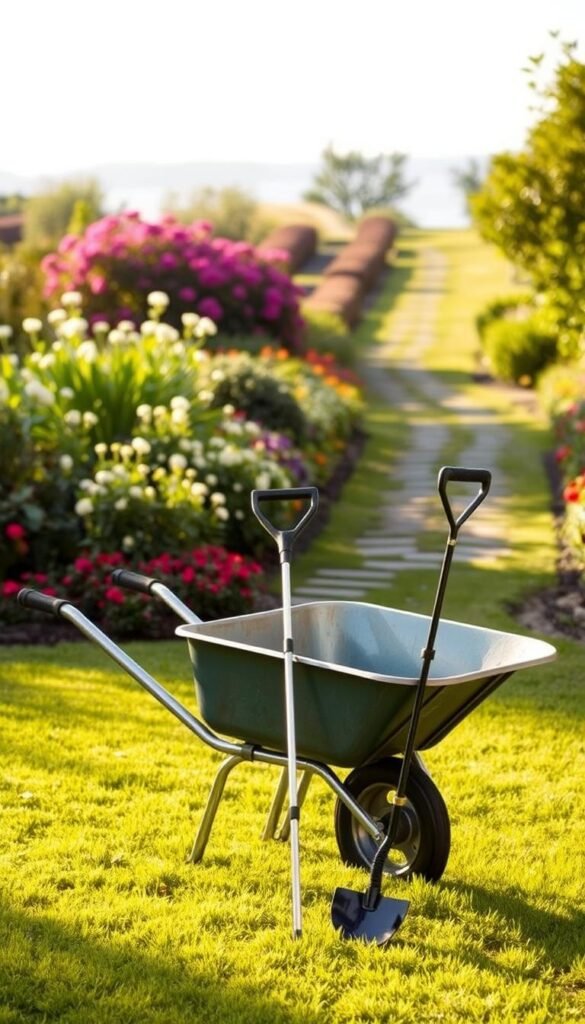
Expanding your collection beyond the basics can make tasks quicker and more enjoyable. While these tools aren’t essential, they save effort and improve precision. From moving heavy loads to hydrating plants evenly, here’s what adds convenience.
Wheelbarrow: Heavy Lifting Simplified
Hauling soil, mulch, or compost becomes effortless with a sturdy wheelbarrow. Opt for a steel or poly tray—both resist rust and cracks. A single wheel offers maneuverability, while dual wheels provide stability on uneven ground.
Watering Wand: Precision Hydration
The Dramm One-Touch Rain Wand delivers gentle streams perfect for delicate seedlings. Its thumb valve lets you control water flow without straining. Choose a 30-inch model to reach hanging baskets—no ladder needed.
| Feature | Showerhead | Watering Wand |
|---|---|---|
| Flow Type | Broad spray | Targeted stream |
| Best For | Lawns or large beds | Containers or under-leaf watering |
| Durability | Plastic (budget) | Brass (top-tier) |
Jeanne Kelley’s under-leaf technique prevents fungal diseases by avoiding wet foliage. Pair your wand with a quick-connect system to share tools or switch attachments in seconds.
Choosing the Right Pruners: Bypass vs. Anvil
Pruning becomes a breeze when you match the tool to the task. Two main types dominate: bypass and anvil pruners. Each excels in different scenarios, from trimming delicate stems to tackling deadwood.
When to Use Bypass Pruners
Bypass pruners work like scissors, slicing cleanly through live branches. Their curved blades prevent crushing, promoting faster healing. Ideal for:
- Fresh growth (up to ¾-inch thickness)
- Precision cuts on roses or fruit trees
- Angled cuts that shed water easily
High-carbon steel blades stay sharp longer. Avoid using them on dry wood—it dulls the edge.
When Anvil Pruners Shine
Anvil pruners crush debris against a flat plate, perfect for dead or thick branches. Key advantages:
- Handles knotted wood (up to 1-inch diameter)
- Ratcheting mechanisms reduce back strain
- Winter pruning—dormant plants won’t stress over blunt cuts
Position branches squarely on the anvil plate for smooth cuts. For arthritis sufferers, look for tools with ergonomic grips.
Soil Tools: Digging, Weeding, and Aerating
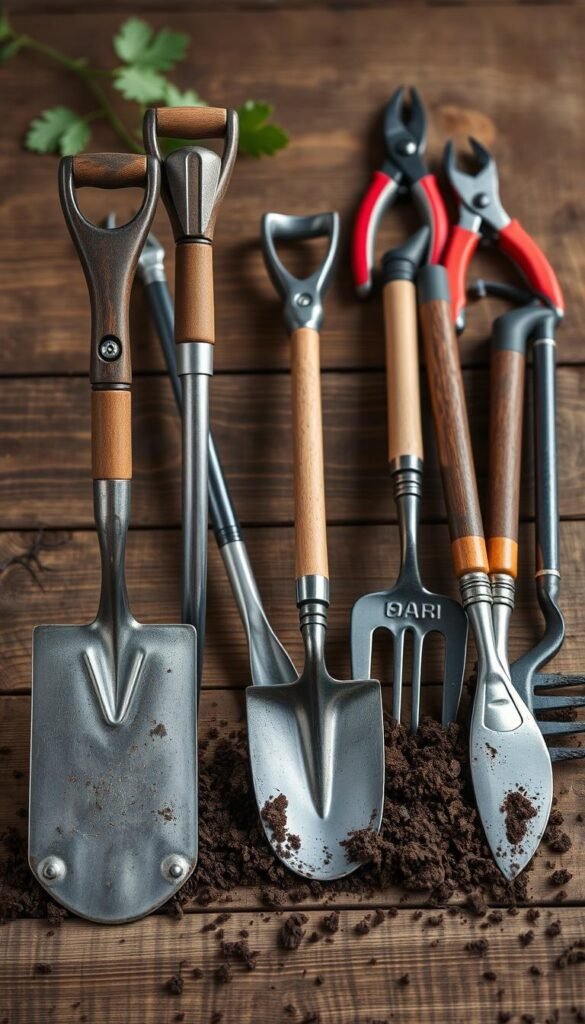
Healthy plants start with well-prepared earth, and the right tool makes all the difference. Whether breaking new ground or maintaining existing beds, specialized implements save time and effort. These two standouts handle multiple tasks while being easy on your hands.
Hori Hori Knife: A Multitasking Marvel
This Japanese-inspired tool combines a knife, trowel, and measuring device. Its serrated edge slices through tough roots, while the concave blade scoops soil effortlessly. Perfect for:
- Creating straight seed rows with its marked measurements
- Dividing perennials with surgical precision
- Harvesting root vegetables without damage
The 7-inch stainless steel blade resists rust and stays sharp through seasons. Use it like a mini-spade for container planting or lever out rocks with its sturdy build.
CobraHead Tool: Weed Warrior
With its unique curved blade, this ergonomic wonder removes weeds at the root. The tempered steel construction slices through clay like butter. Key features:
- Surface weeding: Skim just below the soil to sever small invaders
- Deep removal: Hook taproots with the pointed tip and lift
- Aeration: Twist gently to create air pockets in compacted earth
Compared to traditional hoes, it’s lighter and more precise. Keep your wrist straight and let the garden tool do the work—no back strain.
Watering Essentials for a Thriving Garden
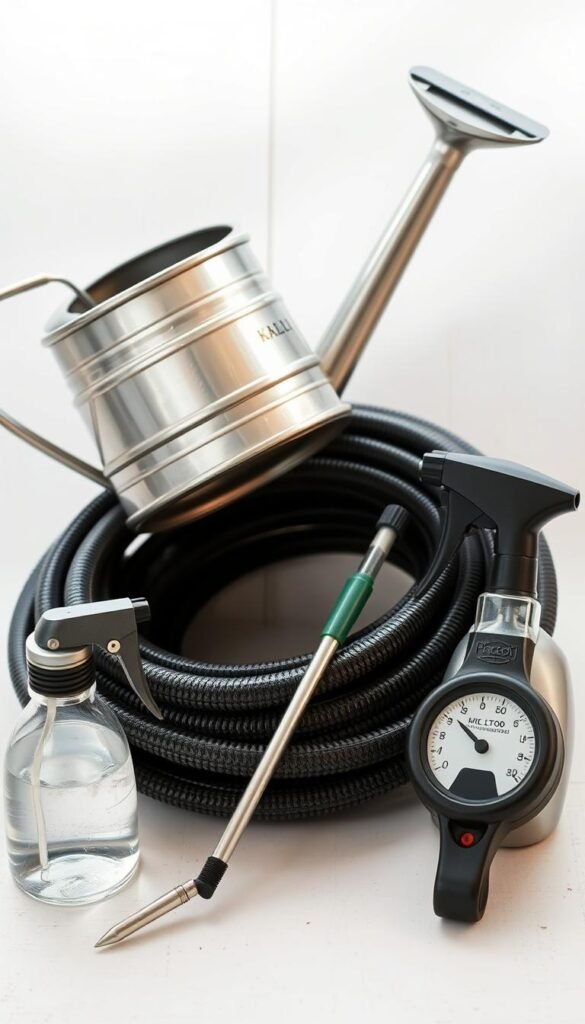
Watering isn’t just about quantity—it’s about precision and timing. The right tools help you deliver moisture efficiently, whether nurturing seedlings or established plants. Below, we’ll explore two game-changers for hydration control.
Hose Nozzles: Control and Convenience
A good nozzle lets you adjust water pressure instantly. Use a shower setting for delicate blooms or a jet stream for deep-rooted vegetable beds. Look for ergonomic grips to reduce hand fatigue during long sessions.
Watering Cans: Lightweight and Portable
The Bloem Deluxe Can balances capacity (2 gallons) with easy handling. Its BPA-free plastic won’t crack in sunlight, and the elongated spout targets soil—not leaves. Perfect for balcony herbs or starting seeds indoors.
- Rose vs. fine spouts: Roses disperse gently for seedlings; fine spouts direct flow to pot edges.
- Mix liquid fertilizers directly in the can—stir with a stick to dissolve granules fully.
- Galvanized steel lasts longer but weighs more; plastic resists rust and stays light.
- Choose light-colored cans to reflect heat and keep water cooler.
- Rinse weekly with vinegar to prevent algae—a simple way to maintain hygiene.
| Feature | Hose Nozzle | Watering Can |
|---|---|---|
| Best For | Large areas, trees | Containers, seedlings |
| Capacity | Unlimited (hose length) | 1–2 gallons (portable) |
| Precision | Adjustable settings | Fixed spout accuracy |
Tool Maintenance: Keep Them Sharp and Clean
Keeping your tools in top shape ensures they last for years. Dull blades and rust slow you down, but simple habits preserve performance. A few minutes of care after each use makes a big difference.
Sharpening Blades for Longevity
A sharp edge slices cleanly, reducing strain on plants and your back. Use a 20-degree angle with a honing file for pruners and spades. Wipe steel blades with oil after sharpening to prevent corrosion.
- Oil-coated wrap: Soak cloth in linseed oil and bundle tools for winter.
- Seasonal checks: Inspect handles for cracks and tighten loose bolts.
- PVC protectors: Slide pipes over shovel handles to prevent splinters.
Proper Storage to Prevent Rust
Moisture ruins even the best tool. Silica gel packs in storage drawers absorb humidity. For sheds, pegboards keep items visible and dry—no more digging through piles.
| Storage Method | Pros | Cons |
|---|---|---|
| Pegboard | Easy access, customizable | Requires wall space |
| Canvas Rolls | Portable, breathable | Limited to small tools |
| Rack Systems | Holds heavy items | Costs more upfront |
An easy way to organize: Hang frequently used garden tools near the door. Label hooks for quick grabs during busy seasons.
Budget-Friendly Alternatives to Pricey Tools
Smart gardening doesn’t require expensive equipment—creativity works wonders. With a few unconventional ideas, you can repurpose household items into functional tools. These swaps save money and reduce waste while keeping your garden thriving.
DIY Dibbers and Seed Starters
Old kitchen utensils shine in the garden. Use a chopstick to poke perfect holes for seeds—an easy way to ensure consistent depth. For seedling trays, egg cartons with drainage holes work beautifully. Just tear and plant the biodegradable cups directly into the ground.
Repurposed Household Items
Turn a 5-gallon bucket into a mobile workstation. Drill holes for drainage, and it becomes a planter, harvest basket, or soil mixer. Cattle panels bent into arches make sturdy trellises for climbing plants. For labels, write on painted rocks or clip binder clips to popsicle sticks.
- Colander soil sifter: Shake soil through the holes to remove debris.
- Coffee mug sharpener: Run pruner blades along the rough bottom edge.
- Laundry basket carrier: Haul fresh produce without bruising.
Plastic bottles with the bottoms cut off become mini greenhouses for seedlings. Press them into the soil to protect plants from frost. Level the ground around the edges to seal in warmth.
Organic Gardening Tools for Pest Control
Protecting your plants naturally keeps them thriving without harsh chemicals. These eco-friendly solutions tackle pests while preserving pollinators and soil health. From sprays to barriers, here’s how to defend your space sustainably.
Neem Oil: Natural Pest Repellent
Cold-pressed neem oil disrupts pests’ life cycles without harming bees. Mix 2 tablespoons per gallon of water and spray at dawn or dusk to avoid leaf burn. Reapply every 7–10 days during infestations.
- Targets aphids, mites, and powdery mildew without toxic residues
- Add a few drops of dish soap to help the solution stick to leaves
- Test on a small area first—some plants like ferns may be sensitive
Diatomaceous Earth: Insect Defense
Food-grade DE dehydrates pests like ants and slugs on contact. Use a bulb duster to apply a thin layer around ground-level stems. Avoid flowers to protect pollinators.
- Reapply after rain—water washes away the powder’s effectiveness
- Wear a mask during application to prevent inhalation
- For slugs, create a ring of DE or crushed eggshells as a sharp barrier
Pro tip: Cinnamon sprinkled near entry points deters ants just as way as DE but needs freshening weekly. Rotate methods to prevent pest resistance.
Get Growing with Confidence
Confidence blooms when you focus on what truly matters. Start with gardening tools that handle the basics—gloves, pruners, and a trowel. Add extras like a wheelbarrow only as your garden expands.
Keep it simple. Maintain blades and handles to save time and money. Join local tool-sharing programs to try before you buy.
Now, pick up your trowel and dig in. Every plant you nurture is a step toward mastery. There’s no better way to grow—both your space and your skills.

